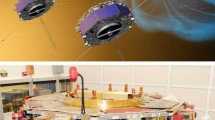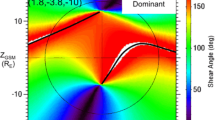Abstract
Using orbital criteria developed in Part 1 of this study (Stern, [1]), a “Profile” constellation mission is developed for studying the Earth’s magnetosphere. The basic “Profile” has six satellites in each of two close orbits with apogee 25RE or 20RE, (Earth radii, 1 RE = 6371 km), but it can be extended to a “Twin Profile” mission with two coplanar constellations (total of twenty-four spacecraft), covering the magnetosphere end-to-end and requiring only one launch. One constellation of twelve then has apogee at midnight (or at other times, dusk), the other at noon (or dawn), and the two exchange positions every six months. The small satellites (17 kg, 29 w) will measure magnetic fields, ion and electron energy spectra, and plasma bulk flows. They require a minimal Δv and can therefore be flung off in pairs from a spinning mother ship, assuring a scientifically desirable spin axis and other benefits. Simulation codes derive the week-by-week coverage of ten magnetospheric regions by the twelve satellites, as well as the annual number of hours certain formations occur, e.g. ten+ satellites within 2RE of the tail’s neutral sheet. Of particular interest is the tight clustering of six to twelve satellites at r > 23RE (for 25RE apogee), enhancing (at various times) local coverage of the substorm reconnection region, low latitude boundary layer and bow shock. The article concludes with a list of thirty targeted scientific investigations, each with its appropriate formation.
Similar content being viewed by others
References
STERN, DAVID P. “Systematic Identification of Preferred Orbits for Magnetospheric Missions: 1. Single Satellites,” The Journal of the Astronautical Sciences, Vol. 49, No. 4, 2001, pp. 559–583.
STERN, DAVID P. “Developing a Strategy for Magnetospheric Research,” Eos, Vol. 77, 165 & 168, 23 April 1996.
STERN, DAVID P. “Planning the ‘Profile’ Multiprobe Mission,” in Science Closure and Enabling Technologies for Constellation Class Missions, V. Angelopoulos and P. V. Panetta, eds., University of California Berkeley, 1998, pp. 136–141. (Also: http://www-istp.gsfc.nasa.gov/profile/Monogrl.htm)
STERN, DAVID P. “Science Tasks for ‘Profile’,” Science Closure and Enabling Technologies for Constellation Class Missions, V. Angelopoulos and P. V. Panetta, eds., University of California Berkeley, 1998, pp. 66–71. (Also: http://www-istp.gsfc.nasa.gov/profile/Monogr2.htm)
STERN, DAVID P. “A Brief History of Magnetospheric Physics During the Space Age,” Reviews of Geophysics, Vol. 34, 1996, pp. 1–31.
SABLICK, M. J., SCHERRER, J. R., WINNINGHAM, D., FRAHM, R. A., and SCHRADER, T. “TEAS (A Tophat for all Species): Design and Computer Optimization of a New Electrostatic Analyzer,” IEEE Transactions on Geoscience and Remote Sensing, Vol. 28, 1990, pp. 1034–1047.
TSYGANENKO, N. A. “Modeling the Earth’s Magnetospheric Magnetic Field Confined Within a Realistic Magnetopause,” Journal of Geophysical Research, Vol. 100, 1995, pp. 5599–5612.
Author information
Authors and Affiliations
Corresponding author
Rights and permissions
About this article
Cite this article
Stem, D.P. Systematic Identification of Preferred Orbits for Magnetospheric Missions: 2. The “Profile” Constellation. J of Astronaut Sci 50, 149–171 (2002). https://doi.org/10.1007/BF03546260
Published:
Issue Date:
DOI: https://doi.org/10.1007/BF03546260




